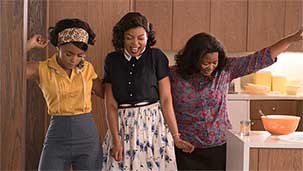As the author of Hidden Figures: The American Dream and the Untold Story of the Black Women Mathematicians Who Helped Win the Space Race it must have been something special to see the world you so meticulously pieced together come to life. But I also wonder how it felt to see your work bent to the necessities of narrative, to see the rough edges shaved off, and important moments discarded because there simply wasn’t enough screen time to include them.
Hidden Figures is the true story of a group of African American women employed by NASA in the heady, Cold War days of the early Sixties. It focuses on three specific women: Katherine Johnson, Mary Jackson, and Dorothy Vaughn, and how fundamentally important they were in the race to get humans into orbit, and finally to the moon.
An example of previously untold stories that feature men and women of colour in crucial historical roles, Hidden Figures also dryly illustrates the often ludicrous hurdles they had to navigate to reach their personal and collective goals. This where Hidden Figures is most effective, as the bare bones of this story are fascinating enough to carry this movie. What was left to the film makers was the delicate task of how much to add and how much to omit.
If this adaptation puts a foot wrong it is in the sometimes awkward conversion of non-fiction to fiction. Too often you can see the stitch-work of the screenplay as it tries to link together events and personalities that sometimes feel shoehorned into the narrative. Kevin Costner’s character, Al Harrison, is an amalgam of three different men, and it feels that way despite what is a fairly solid performance.
If that had been a single instance, it would have been easy to pass by, but sadly, in a year of otherwise virtuoso supporting actor performances, Mahershala Ali’s character also feels like he is there simply to check a particular box; a paper thin contrivance used to fill out Katherine Johnson’s domestic circumstance.
The cookie-cutter script sometimes undermines what is a fascinating, and for me, completely undiscovered story about African American women and their vital role in achieving the first American manned flight to orbit the earth. But these shortcomings can’t obscure what is, at its core, a compelling story about how perseverance and community can overcome seemingly intractable obstacles. Katherine Johnson’s story, in particular, is inspirational and the filmmakers made a wise decision to foreground her journey.
Certainly it is a difficult task to find a way to navigate through complex historical moments without it feeling a little bit like something you see in a high school science class on film day. But given that I was still completely taken by these women’s stories and how they spit (usually more gently than the situation warranted) in the face of often contemptible behaviour on the part of both the nation and NASA itself, it was worth the time and effort required.
I hope you came away from the experience happy to see a film that will, however imperfectly, aid in getting this story to a far wider audience. I guess that is the deal with the devil you sometimes have to make.
Sincerely,

Tim







